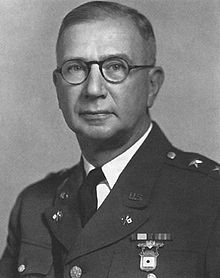Joseph Mauborgne
|
Chief Signal Officer, U.S. Army Joseph Oswald Mauborgne |
|
|---|---|
 |
|
| Born |
February 26, 1881 New York, New York |
| Died | June 7, 1971 (aged 90) Atlanta, Georgia |
| Allegiance |
|
| Service/branch |
|
| Years of service | 1903-1941 |
| Rank |
|
| Commands held | Chief Signal Officer |
| Battles/wars | World War I |
| Awards |
Distinguished Service Medal World War I Victory Medal American Defense Service Medal |
Joseph Oswald Mauborgne (February 26, 1881 – June 7, 1971) co-invented the one-time pad with Gilbert Vernam of Bell Labs. In 1914 he published the first recorded solution of the Playfair cipher. Mauborgne became a Major General in the United States Army, and from October 1937 to his retirement in 1941 was the Army's 12th Chief Signal Officer, in command of the Signal Corps.
Mauborgne was born on February 26, 1881 in New York City to Eugene and Catherine Elizabeth McLaughlin Mauborgne. After graduating in 1901 from the College of Saint Xavier in New York, he studied fine arts until commissioned a 2d Lieutenant, Infantry, in the regular Army in 1903. Stationed in the Philippines several times at several infantry posts, Mauborgne attended the Army Signal School at Fort Leavenworth, Kansas, in 1909-1910, graduating from the Signal Officers Course, followed by a tour of duty in Washington D.C. in the office of Chief Signal Officer Brigadier General George P. Scriven.
While stationed at Fort Riley, Kansas, in 1912, he installed a radio transmitter in an airplane and had 1st Lt. Henry H. Arnold send him the first successful air to ground radio transmission on November 2. Two years later, while in command of the radio station at Fort Mills on Corregidor, Mauborgne went up himself with 2nd Lt. Herbert A. "Bert" Dargue in a Burgess Model I seaplane to conduct a series of experimental flight tests of an airborne radio, and made the first two-way radio telegraphy between an airplane and a station on the ground on December 16, 1914. After World War I, in the 1920s and 1930s, Mauborgne pursued communication advancements in numerous research-and-development assignments, including a stint as chief of the Signal Corps Engineering and Research Division and as commander of the Signal Corps laboratory in the Bureau of Standards. During the early 1930s, Mauborgne was Signal Officer for the 9th Corps Area and later Director of the Signal Corps Aircraft Factory, Wright Field, Ohio. He attended the Army War College during its 1931-32 academic session.
...
Wikipedia
